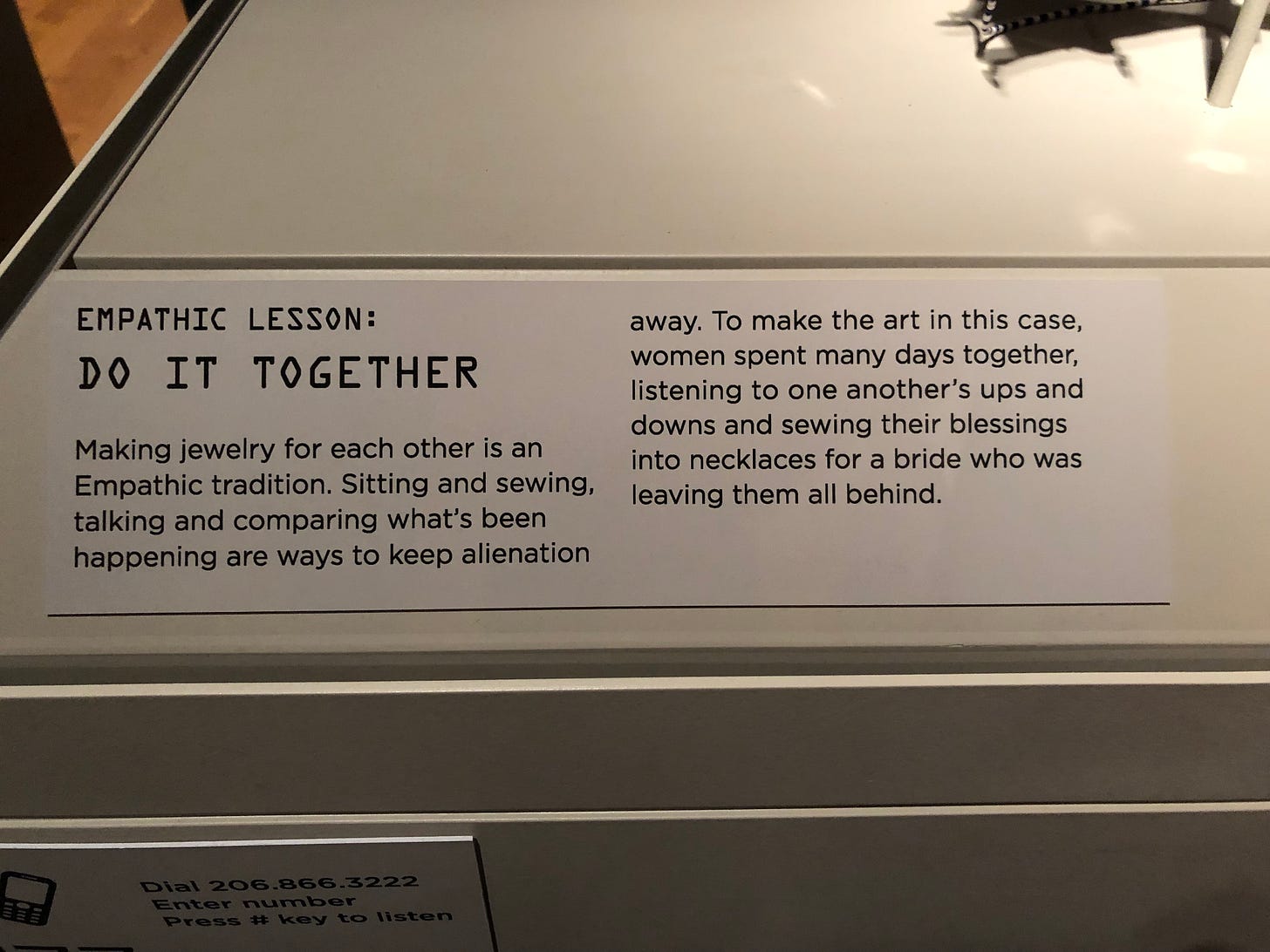Walls
A few thoughts on grief’s default defensive mechanisms.
February 24, 2019
Grief builds walls. And though they’re not made of heavy concrete, sometimes they feel just as impenetrable, like you’d need a jackhammer and an overnight highway crew to get through.
I’ve found that my barriers are visible through cold, emotionless body language. One-word answers. Grunts—they type of pre-language noises Dad would use to communicate with Mom when he wanted to be left alone.
My walls are made of physical and mental energy—it takes real effort to make your face blank, to set your jaw, to assume a chilly quietness that’s quite the opposite of your normal demeanor. And when you do talk, to make sure that whoever’s listening feels out of line, or worse. It’s hard work, even if you don’t notice you’re doing it.
When grief slowly tightens its grip around me, I willingly build these walls and reinforce them. Dad could do this like a pro. I’m sure I learned the technique from him. And while he employed them when he wanted to maintain peace and quiet, or focus on a project in his shop, or just get out the door to go for a run, I find that I use them when I don’t want to talk about what’s happening with me. Maybe he did that, too. He would’ve never admitted it.
Grief is painful. And expressing pain—quite logically, actually—requires a certain courage to be comfortable being uncomfortable; it means understanding that voicing vulnerability is, counterintuitively, something that projects confidence and strength to those around you.
And so I see my walls as rudimentary defense mechanisms. I raise them up to make sure that my pain is hidden, kept inside, where no can see it but me. Think of a nastier version of a stare that says, “I’ve got nothing nice to say right now so don’t make me say what I’m thinking.” Sure, this keeps others from seeing the grief—but it also fends off love and support. Cold stares and tight, hunched shoulders send pretty clear signals to go away.
The trick is that letting my guard down and becoming vulnerable, knocking down the walls, isn’t an automatic invitation for sympathy for those beyond them. While grief can be eased by expressing it and talking through it, I’ve found that it’s not always easily shared among others that are suffering, let alone those who are not. I’ve come to think that the deepest and most difficult part of this pain is that—even standing in a group of people all saying the Mourner’s Kaddish together—you are somewhat alone in your own feelings.
Diving into those feelings to explore them is always hard for me. I’ve often told Michelle that I knew I wanted to be with her when I realized that she was the first person who’d encouraged me to grab at these feelings guarded by hulking walls and muster the strength to end my personal siege. If we’re all okay with me mixing metaphors for a moment: I used to tell her that these types of feelings—whether they come from a place of shame or complex sadness—required me to leap over an emotional gap to meet her on the other side. As we’ve grown together, I’ve explained to Miche that the gap hasn’t gotten narrower—I’ve just gotten better at summoning the courage to jump it.
And so I say what I do about sympathy because I’ve found that empathy is the much more effective practice. Empathy requires a good ear, trust, self-awareness—all actions that need to draw on a source patience in a world that is brimming with technology clambering to eliminate the need for it.
This weekend in Seattle, Miche and I hosted to her father Jack. The three of us visited the Seattle Art Museum, which this month features an exhibit about empathy in a gallery on its topmost floor. A mix of cultural artifacts line the walls, while masked, life-size human figures wearing masks are posted throughout the gallery in various states of expression and dress. Each display offers a different empathic lesson from one of these cultures. The exhibit itself tells visitors of a great deficiency of empathy building in the world (something an institute claims to have diagnosed), and asks one to take a moment to open oneself to different perspectives, feelings, and experiences.
Each different display shared a different empathic lesson:


The process of doing this is hard. To remove my own prejudices and assumptions from what I observe in a moment and to force myself to listen without anticipation and prefabricated conclusions is hard—and yet it is perhaps the most healing thing I could ask of a loved one as I continue this difficult journey beyond my walls.
Media of the Moment
On Jussie
Speaking of empathy and patience, on Thursday this week I pulled myself back from making conclusions and assumptions while reading more news from the ongoing events surround Empire cast member Jussie Smollett.
When I walked into work on Thursday, I poured myself a cup of coffee and checked the New York Times, seeing a headline that Smollett had been arrested and charged—that police were claiming the whole thing was a hoax and a waste of time.
The way the Times article was written, (‘Prosecutors Say’ was the final clause in the headline), I found myself subconsciously presuming guilt. Then, as I quickly texted with a group of college friends who thoughtfully challenged the apparent veracity of the article, I pulled out two different articles on Smollett that had run nearly concurrently from Buzzfeed News and Vox.
Read all three, consider the headline writing and the tone, and the case returns from the seeming finality of the Times piece into the complicated, not-all-the-facts-are-now discomfort that’s appropriate for the moment.
So here they are:
“Jussie Smollet Rehearsed His Own Assault, Prosecutors Say”-NY Times
"It's Simply Shameful": Chicago Police Blast Jussie Smollett For Staging A "Publicity Stunt"-Buzzfeed News
Jussie Smollett charged with filing false report of a hate crime-Vox
There have been some updates to the articles since I read them earlier this week and there’s not exactly a direct through-line between practicing empathy, but I do think there’s something to be said for not letting a news source (even if it is the New York Times) help you presume someone’s guilt before a trial.
What We Watched This Week
All HBO this week, folks. Borrow a password from a friend if you don’t have an account (that’s what we do).
• True Detective continues! There’s one episode left of the current season.
• United Skates, an HBO documentary about black culture at roller rinks and the unsurprising disappearance of these spaces for folks to gather.
• John Oliver’s excellent news show Last Week Tonight is back. His ridiculous asides are more and more predictable these days, but the reporting is still great and I will never not be here for the show’s supercuts of embarrassingly clueless local news anchors.
What We’re Reading This Week
• Still Tree of Smoke. This book is long.
• Reading to go with your Oscars evening (and why I won’t watch Bohemian Rhapsody): the Atlantic’s investigative piece on fired Bohemian Rhapsody director Brian Singer (The Usual Suspects, Apt Pupil).
• For work: Douglas Rushkoff’s Team Human, an easy-to-read manifesto about the antihuman agenda of the tech and markets we obsess over every day.
What I Listened To This Week
• Michelle and I went out and saw my longtime favorite jazz trio The Bad Plus at Seatttle’s Dimitrou’s Jazz Alley this week—dumb club name, great room and show. They’ve added a new pianist in the last year and a half, Orrin Evans, and he was a great fit. If you’ve never heard of the trio, I recommend their cover of the theme from Chariots of Fire.
That’s all this week. Send me an email with your True Detective reactions later in the week. Hold your emails until Tuesday or Wednesday—we’re waiting on TD’s final episode until after the Oscars.
